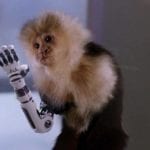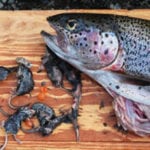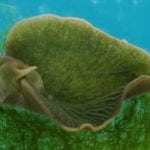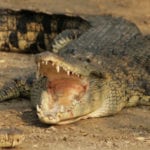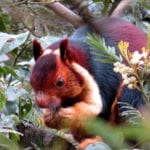 Mysteries
Mysteries  Mysteries
Mysteries  History
History 10 Surprising Stories About the Texas Rangers
 Humans
Humans 10 Philosophers Who Were Driven Mad by Their Own Theories
 Miscellaneous
Miscellaneous 10 Video-Game-Worthy Weapons and Armors from History
 Weird Stuff
Weird Stuff 10 Psychics Who Accurately Predicted Wartime Events
 The Arts
The Arts 10 Pieces of Art Inspired by a Broken Heart
 Health
Health 10 Science Fiction-Sounding New Medical Treatments
 History
History 10 Surprising Facts About the Father of Submarine Warfare
 Space
Space Ten Astonishing New Insights into Alien Worlds
 Weird Stuff
Weird Stuff 10 Bizarre Summer Solstice Rituals Still Practiced Today
 Mysteries
Mysteries Top 10 Haunting Facts About the Ghost Ship MV Alta
 History
History 10 Surprising Stories About the Texas Rangers
 Humans
Humans 10 Philosophers Who Were Driven Mad by Their Own Theories
Who's Behind Listverse?

Jamie Frater
Head Editor
Jamie founded Listverse due to an insatiable desire to share fascinating, obscure, and bizarre facts. He has been a guest speaker on numerous national radio and television stations and is a five time published author.
More About Us Miscellaneous
Miscellaneous 10 Video-Game-Worthy Weapons and Armors from History
 Weird Stuff
Weird Stuff 10 Psychics Who Accurately Predicted Wartime Events
 The Arts
The Arts 10 Pieces of Art Inspired by a Broken Heart
 Health
Health 10 Science Fiction-Sounding New Medical Treatments
 History
History 10 Surprising Facts About the Father of Submarine Warfare
 Space
Space Ten Astonishing New Insights into Alien Worlds
 Weird Stuff
Weird Stuff 10 Bizarre Summer Solstice Rituals Still Practiced Today
Top 10 Cutest Animals In The World (According To Science)
People generally agree on what makes an animal adorable, and there’s a good reason for that. What we consider cute is determined by our evolution, which ensures we pay attention to human babies.
This has spilled over into other animals, and for the most part, baby animals of all kinds tend to attract our attention. For an animal to be cute, they need to have the traits of a baby schema, which activates our mesocorticolimbic system, making us squeal with delight at cute critters.
Whether its due to a disproportionately large, round head, or large eyes that capture the heart, these ten animals take full advantage of a human’s need to love babies.
10 Animals We Failed To Domesticate
10 Most Baby Mammals
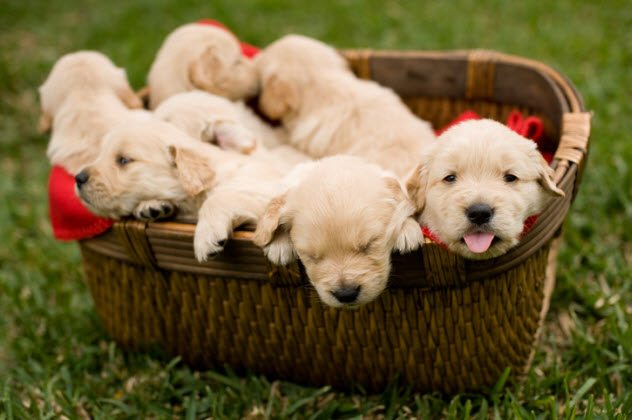 Why They Are So Cute: Baby Schema
Why They Are So Cute: Baby Schema
In general, almost all baby animals are considered cute by people, which is one of the ways they have been domesticated over the years. Taking a look at one of many species, Canis lupus familiaris, otherwise known as the domesticated dog, evolved to survive by passing down the genes that make them cute. Seriously. Dogs took full advantage of humanity’s need to love cute things by ensuring their offspring had all the traits we appreciate. They are small, their head is large relative to their body, and their eyes are large relative to their head.
Nearly every mammalian species follows this trend, but those who don’t are often considered pest species. Rodents, for example, are typically hairless and unable to open their eyes when they are born. This is true of most birds, and other species people don’t regularly squeal in delight at seeing. Interestingly, the nature of “cuteness” in terms of baby animals has been studied extensively, with some studies pointing to the fact that baby animals often score higher in terms of the baby schema than most human babies.[1]
9 Slow Loris
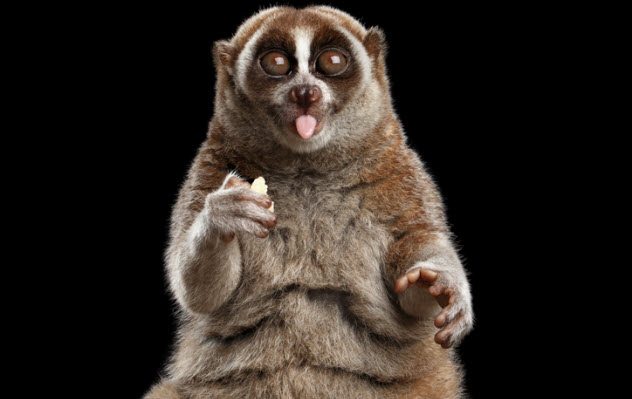 Why They Are So Cute: Enlarged Eyes
Why They Are So Cute: Enlarged Eyes
If you’ve ever seen those plush toys with impossibly large eyes, that’s one of the ways toy manufacturers use our innate desire for cuteness to entice a purchase. One of the animals that don’t need any help in that area is the Slow loris. There are multiple Slow loris species, but they all share some of the same key features, which we find to be universally adorable. The most prominent of them is their enlarged eyes, which weren’t evolved to make them desirable to humans; rather, they are an adaptation to their nocturnal lifestyle.
Slow lorises have a small snout and nose and enlarged eyes, which check multiple boxes on the baby schema. As a result, most people who see them consider them to be cute, but their cuteness should not entice anyone to approach these tiny primates. The bite of a Slow loris is highly toxic, which is rare among mammals. It is derived from licking a sexual gland on their arm, which secretes a liquid that combines with their saliva to become toxic. They spread this substance on their fur as a deterrence to predators. Slow lorises are cute, but they’re more of a ‘look but don’t touch’ kind of species.[2]
8 Meerkats
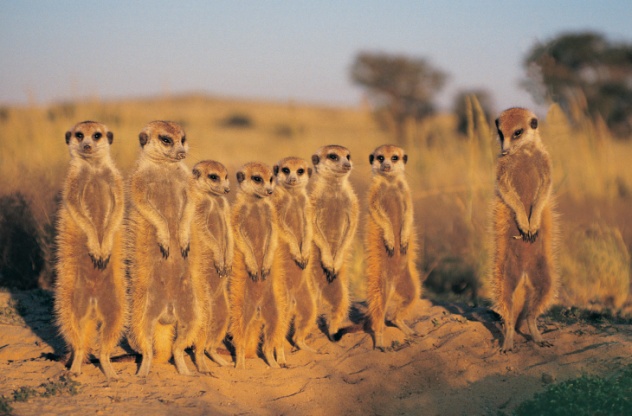 Why They Are So Cute: Enlarged Eyes, Head, And Social Behavior
Why They Are So Cute: Enlarged Eyes, Head, And Social Behavior
Meerkats are small mongooses native to southern Africa, and they are some of the cutest social animals on the planet. They live in large packs of up to 30 individuals and have a quirky survival instinct. It calls for one or more meerkats in a group to sit or stand on their hind legs outside their burrow to watch for predators. This gives them their well-known stance that can be seen in zoos around the world, but for most people, it’s not a survival instinct, it’s just cute behavior. In reality, it’s anything but cute, as they are on constant alert for predatory birds and other threats.
A typical meerkat has a broad head, enlarged eyes, small outer ears, and a pointed snout. All of its facial features make it cute according to the baby schema. While the adults have their appeal, meerkat babies are disturbingly cute — more so than most baby animals. Because of their size, their heads are enlarged, and so are their eyes. They grow into their bodies as they mature, but the babies often evoke an “aww” response from most people. This is also true of meerkats, who altruistically care for each other’s babies, which is rare in most species.[3]
7 Koala
 Why They Are So Cute: Rounded Heads
Why They Are So Cute: Rounded Heads
Koala Bears are cute, they’re cuddly, and they should be avoided at all costs. It’s generally accepted that these marsupials endemic to Australia are considered cute by most people. Still, koalas are another animal that is cute but should be avoided. This is due to their sharp teeth and claws, which they are more than ready to use if they feel threatened. Koalas are listed as “threatened,” and their numbers took a severe hit from the 2020 Australia wildfire season. Despite widespread habitat loss, the koala’s survival may be helped by the simple fact that we think they’re cute.
People are more inclined to help save a species if we consider it cute. This is evident by how much time and money go into protecting the koala vs. saving a species of slug. One of the main features we find adorable in koalas is their large, round heads and small features. These mirror the heads of our own babies, which goes a long way in attracting people to their plight. Other aspects, like the fact that they sleep for 20 hours a day, move slowly, and have fuzzy ears don’t hurt their widespread appeal.[4]
6 Flapjack & Dumbo Octopodes
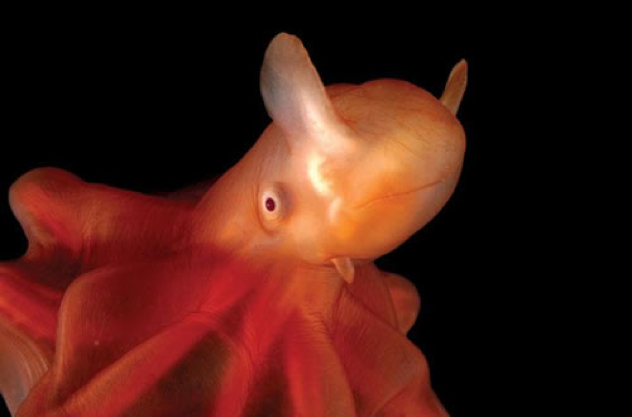 Why They Are So Cute: Large Eyes & Diminutive Features
Why They Are So Cute: Large Eyes & Diminutive Features
In many cases, animals are cute to humans due to our interactions with them over tens of thousands of years of evolution. Other times, their cuteness is entirely coincidental. Such is the case in a species of Flapjack octopus, which is, of all things, adorable. The species was discovered in 2015, and it almost looks like a ghost from Pac-Man. They are bright pink, have stubby tentacles, and large eyes. They are abyssal creatures, which means they evolved to survive in the deep sea on the ocean floor, so their cuteness has nothing to do with human appreciation, though it’s certainly a perk.
While they aren’t the only species of Flapjack octopus in the ocean, their scientific name has been proposed as Opisthoteuthis adorabilis, which seems fitting. Diminutive Flapjack octopuses aren’t the only species of octopus that people consider to be cute. The so-called Dumbo octopus shares similar traits, but has large flaps that look like the large ears of the Disney character. Speaking of Disney characters, the adorable little octopus, Pearl, from Finding Nemo was based on Opisthoteuthis californiana, another species of flapjack octopus, though she was arguably cuter than the real thing.[5]
Top 10 Most Expensive Animals Ever Sold
5 Piglets
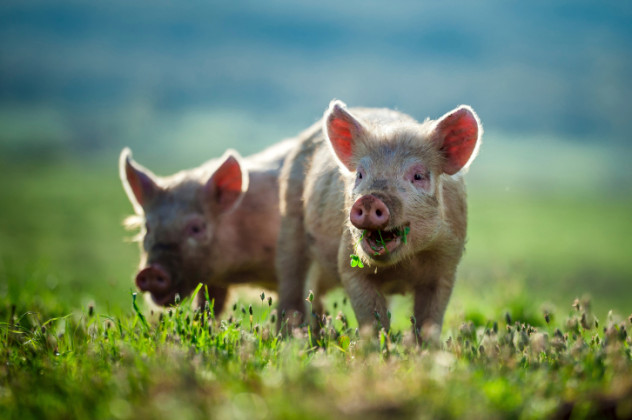 Why They Are So Cute: Small, Enlarged Noses, & Large Eyes
Why They Are So Cute: Small, Enlarged Noses, & Large Eyes
Pigs are an interesting animal for this list due to the fact that a piglet is cute, but a pig is anything but. That fact has been a problem in the pet trade, as people will happily adopt a piglet, but when that animal matures, it goes from being a small, cute animal to a massive beast best suited for bacon. A piglet checks several boxes on the baby schema, as they have short snouts with enlarged noses, large heads and eyes compared to the rest of their bodies, and they have a rounded face.
A typical piglet weighs around 35 lbs. (15.9 kg) at eight weeks, and that’s a manageable size for many household pets. Many dogs weigh much more but take that same piglet at six months, and depending on the species, you could be stuck with a pig weighing in at an average of 250 lbs (113 kg) or more. Unlike other animals on this list, the longer a pig is around humans, the less desirable in terms of cuteness they become. This has long been a problem in the so-called “Teacup pig” pet trade, as anyone who owned one will know; they lose the cuteness when they get huge.[6]
4 Fennec Fox
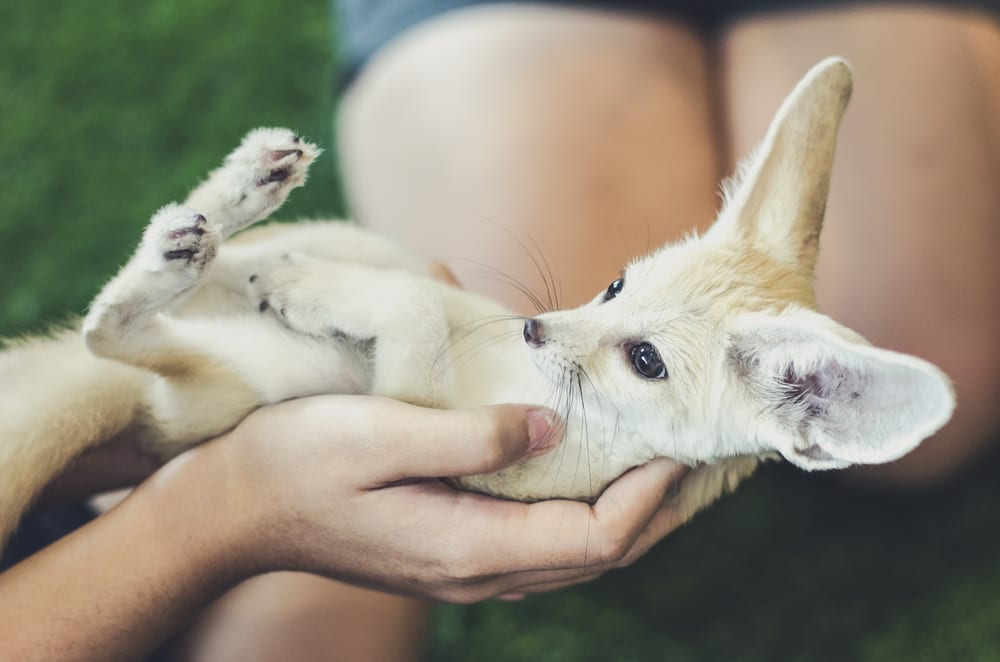 Why They Are So Cute: Small Features & Enlarged Ears
Why They Are So Cute: Small Features & Enlarged Ears
The Fennec fox is a small species of fox native to the Sahara Desert and the Sinai Peninsula. They are highly adapted to their desert environment, thanks in large part to their ears. In mammals, the larger the years, the more capable they are at dissipating heat, which is the main reason the African Elephant has the largest ears in the world. For the Fennec Fox, their ears aren’t the only adaptations that make it possible for them to live in the desert. Their kidneys and fur coat are likewise adapted to make it possible to survive in a hot, water-poor environment.
When it comes to cuteness where humans are concerned, they are prized by people for their massive ears, which are the largest ear to body ration in the canid family. That’s an important distinction, as the Fennic fox is the world’s smallest canid in the world. Their maximum weight has them at between 2.9 to 4.3 lbs. (1.3 to 1.9 kg). Fennec foxes have not been domesticated, but they are often sold as exotic pets. This is accomplished through taming after removing pups from their mothers to hand-raise them.[7]
3 Red Panda
 Why They Are So Cute: Enlarged Dark Eyes, Small Features, And Rounded Face
Why They Are So Cute: Enlarged Dark Eyes, Small Features, And Rounded Face
When the Red panda was first described by Frédéric Cuvier in 1825, he dubbed it “quite the most handsome mammal in existence.” They have been described in the years since in a number of ways, but Seth Meyers probably said it best when he said, “They’re like a fox and a raccoon and a bear and a dog and a cat. They’re like every adorable animal in one animal.” While it’s not a scientific description, anyone who has seen one of these creatures would likely agree with him.
Red Pandas are considerably smaller than the giant panda, which makes sense, as they aren’t closely related. Their long fuzzy tails are another feature people like, but they are an endangered species despite their widespread appeal. Their main threats are habitat loss from competition with domestic livestock, deforestation, and human harvesting, both alive and dead. Conservation efforts have been in place since 2008, and the species has recovered in some areas. Additionally, captive breeding programs have been largely successful around the world.[8]
2 Sea Otters
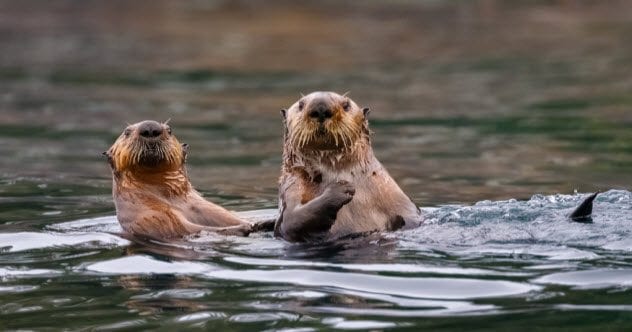 Why They Are So Cute: Social Behavior, Large Eyes & Noses, Rounded Faces
Why They Are So Cute: Social Behavior, Large Eyes & Noses, Rounded Faces
Sea otters are some of the cutest animals in the world, and while that has a lot to do with their features, their social behavior is what brings most people to zoos to see them. Sea otters regularly hold one another’s hands while they sleep. This serves as a survival mechanism that keeps them together so they don’t drift apart. It also mirrors human behavior, which is something we find cute in other species. The sea otter is only concerned with not floating away, but for a human, it’s little more than adorable behavior on display.
Another interesting behavior of sea otters is that they have a pouch where they keep their favorite rocks, which they use to break open various shellfish. They have also been known to play with toys in captivity and makeshift toys in the wild, which is similar to the behavior of puppies. Much of their behavior appears to mirror our own, but their physical features are appealing to most people as well. They have large noses and eyes sitting in a rounded face, which are all within the baby schema that attracts people to other animals.[9]
1 Quokka
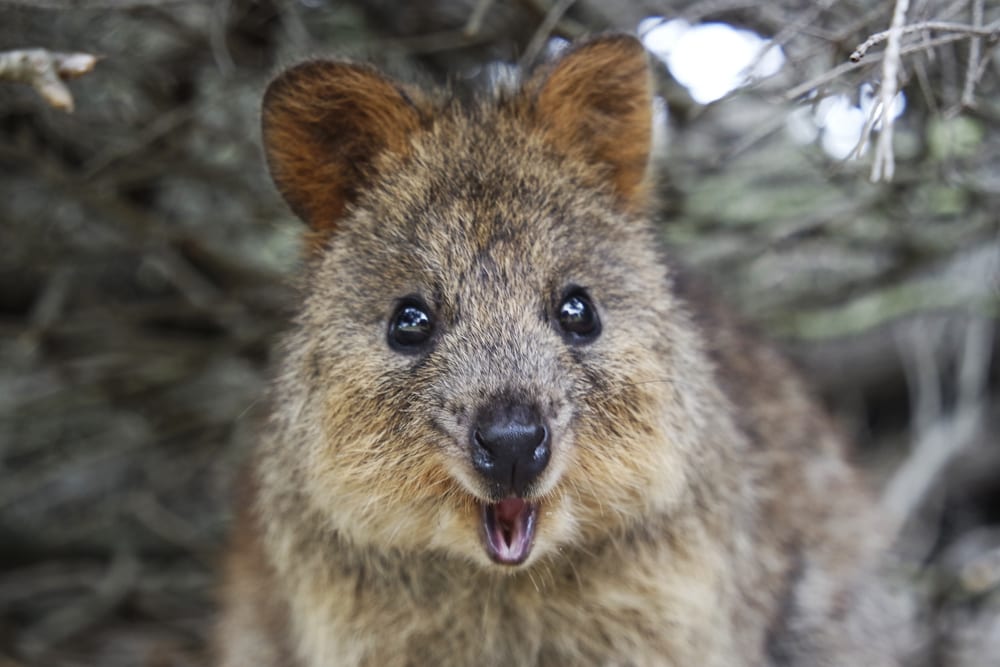 Why They Are So Cute: They Smile, Have Enlarged Eyes, Small Features, And A Pointed Snout
Why They Are So Cute: They Smile, Have Enlarged Eyes, Small Features, And A Pointed Snout
Quokka are small marsupials in the same family as kangaroos and wallabies native to southwestern Australia. They are widely known worldwide due to their unique facial expression, which looks very much like a smile, and this is something humans have spread online in recent years. Quokka are so beloved for their expressions; most people who find them in the wild do exactly what they shouldn’t: they take a selfie with them. This has resulted in scores of adorable pictures of people posing with wild animals, but it has also resulted in several bites because… well, they’re wild animals.
Regardless, quokka generally aren’t fearful of humans, and their penchant for smiling has dubbed them “the world’s happiest animals.” But while they are definitely cute, they shouldn’t be interacted with in the wild, as they are currently listed as vulnerable and are in need of protection.[10]
Top 10 Horrific Ways Animals Were Used For Entertainment
